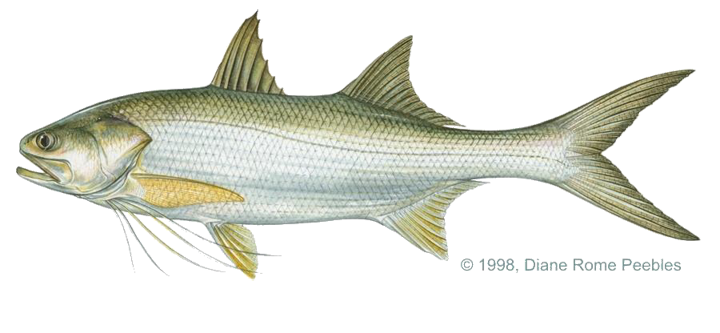Game Fish Identification Reference Guides
Threadfin, king
(Polydactylus macrochir)
(Polydactylus macrochir)

(Macleay); POLYNEMIDAE FAMILY; also known as threadfin salmon, Burnett salmon, Cooktown salmon, tassel fish, putty nose
It is found from the Queensland coast of Australia to the Gulf of Papua. Most abundant in the Northern Territory and northern part of Western Australia, it is a species of shallow coastal waters, occurring over muddy bottoms and in rivers, bays, and estuaries.
Its most obvious feature is the long, trailing filaments that extend from the pectoral area (around the throat), and which serve as feelers in the murky, discolored waters with which threadfins typically are associated.
It is one of the largest threadfin species, attaining weights of over 66 lb (30 kg). It is distinguished from similar species of its family by the fact that is has five filaments (as opposed to three or four in most Indo Pacific species) and by its pectoral fin rays, which are simple instead of branched. The Indian threadfin (Polynemus indicus), another large species, also has five filaments, but its pectoral rays are branched, each ray forming a pair at the extremity.
Its color is generally silvery with a darker, blue grayish back. The pectoral fins are orangish; the dorsal fins and tail, slaty gray. Live fish may have a golden to pinkish flush over the silvery sides, and this is believed by some to have led to the misnomer, “salmon” In fact, the threadfins are in no way related to the salmons or to their relatives of the Salmonidae family.
It has a deeply forked tail and two fairly large dorsal fins of approximately equal size. The tail lobes are long but do not end in extended filaments as they do in the Indian threadfin. The single anal fin is similar in size and shape to the second dorsal fin.
Fishing for threadfins is best when a run in or run out tide is underway, clouding and muddying up the waters, at the mouths of estuaries and saltwater creeks. It seems to prefer foraging for its food (crabs, prawns, and the like) under the cover of a top layer of sediment. Live baits fished at night have also been known to catch large specimens, as have poppers and plugs at dusk. It is a “lazy” swimmer like the bonefish when foraging, but might be described as a tornado on a string once hooked, seemingly going in all directions at once. It may also leap from the water or streak off on long runs.
It is frequently compared with the barramundi for its eating quality
It is found from the Queensland coast of Australia to the Gulf of Papua. Most abundant in the Northern Territory and northern part of Western Australia, it is a species of shallow coastal waters, occurring over muddy bottoms and in rivers, bays, and estuaries.
Its most obvious feature is the long, trailing filaments that extend from the pectoral area (around the throat), and which serve as feelers in the murky, discolored waters with which threadfins typically are associated.
It is one of the largest threadfin species, attaining weights of over 66 lb (30 kg). It is distinguished from similar species of its family by the fact that is has five filaments (as opposed to three or four in most Indo Pacific species) and by its pectoral fin rays, which are simple instead of branched. The Indian threadfin (Polynemus indicus), another large species, also has five filaments, but its pectoral rays are branched, each ray forming a pair at the extremity.
Its color is generally silvery with a darker, blue grayish back. The pectoral fins are orangish; the dorsal fins and tail, slaty gray. Live fish may have a golden to pinkish flush over the silvery sides, and this is believed by some to have led to the misnomer, “salmon” In fact, the threadfins are in no way related to the salmons or to their relatives of the Salmonidae family.
It has a deeply forked tail and two fairly large dorsal fins of approximately equal size. The tail lobes are long but do not end in extended filaments as they do in the Indian threadfin. The single anal fin is similar in size and shape to the second dorsal fin.
Fishing for threadfins is best when a run in or run out tide is underway, clouding and muddying up the waters, at the mouths of estuaries and saltwater creeks. It seems to prefer foraging for its food (crabs, prawns, and the like) under the cover of a top layer of sediment. Live baits fished at night have also been known to catch large specimens, as have poppers and plugs at dusk. It is a “lazy” swimmer like the bonefish when foraging, but might be described as a tornado on a string once hooked, seemingly going in all directions at once. It may also leap from the water or streak off on long runs.
It is frequently compared with the barramundi for its eating quality












